During a trip to Liverpool in March 2023, amongst many other things, the author of this webpage decided to go in search of some locations associated with, and learn a bit more about the life of, English inventor, businessman, and politician, Frank Hornby. Many will associate his name with model railway trains, although as well as Hornby Model Railways, he was also responsible for the invention and production of two other popular lines of 20th century toys based on engineering principles, namely Dinky Toys and Meccano. The author’s late father was a very keen Meccano enthusiast and having grown up fully aware who Frank Hornby was, it was decided to seek out some of the places relating to the life of Hornby, who himself came from the nearby Merseyside town of Maghull.

The Life of Frank Hornby
Frank Hornby was a remarkable man who transformed the world of toy making with his inventions of Meccano, Hornby Model Railways and Dinky Toys. He was also a successful businessman and a politician who served as a Conservative MP for Everton from 1931 to 1935. He was born in Maghull, Merseyside, on 15 May 1863 and died here too, on 21 September 1936.
 |
 |
Above: Frank Hornby’s grave in the grounds of St Andrew's Church, Maghull, Merseyside. His grave is marked by a simple stone that reads: "Sweet Remembrance of Patricia, the dearly loved and only daughter of Frank & Clara Hornby who fell asleep 15th June 1919, in her 14th year. Also of Frank Hornby father of the above who died September 21st 1936 aged 72 years. Also of Clara Hornby beloved wife of Frank who died 13th October 1953 aged 92 years".
Hornby's interest in engineering and mechanics started when he was a young boy. He liked to tinker with metal scraps and make models of bridges, cranes and trucks. He had no formal education in engineering, but he had a natural talent and a keen imagination. He worked as a cashier and a bookkeeper for his father's and his employer's businesses until he was 36 years old. In 1898, Hornby had a breakthrough idea that changed his life and the toy industry. He realised that he could make interchangeable metal parts that could be bolted together to create different models. He also devised a system of regular perforations in the metal strips that could be used to attach axles and shafts. This was the birth of Meccano, a construction toy that allowed children and adults to build their own mechanical devices.
Hornby patented his invention in 1901 and started producing Meccano sets in a small workshop in Liverpool. He soon realised that he needed more capital and space to expand his business, so he formed Meccano Ltd in 1908 and moved to a larger factory in Binns Road, Wavertree, Liverpool. He also launched Meccano Magazine in 1916, a monthly publication that featured articles, stories, competitions and advertisements related to Meccano and other hobbies.
|
|
|
Above: Frank Hornby Blue Plaque on the front of 'The Hollies', Station Lane, Maghull. Frank and his family lived here from 1908 to 1920. The Hollies was the first building outside London to be awarded a blue plaque by English Heritage to commemorate Hornby's achievements. The private building was awarded the plaque on the 6th July 2000.
Hornby's success with Meccano led him to develop other toys based on engineering principles. In 1920, he introduced Hornby Model Railways, a line of electric trains that ran on metal tracks with realistic accessories. In 1934, he launched Dinky Toys, a range of die-cast miniature vehicles that were popular with collectors and children alike. Hornby's toys were innovative, durable and educational, and they appealed to people of all ages and backgrounds.
Hornby was not only an inventor and a businessman, but also a politician. He was interested in social issues and public welfare, and he joined the Conservative Party in the 1920’s. He ran for parliament in 1929 but lost by a narrow margin. He tried again in 1931 and won the seat for Everton with a comfortable majority. He served as an MP for four years until he retired due to ill health in 1935. He died the following year at the age of 73.
Frank Hornby was a visionary who left behind a legacy of creativity and innovation. His toys inspired generations of children and adults to explore the world of engineering and mechanics. His inventions are still cherished by enthusiasts and collectors around the world today.
Binns Road, Liverpool
The Meccano Binns Road site was the location of the famous Meccano factory in Liverpool, where some of the most iconic toys of the 20th century were produced.

Above: Former site of the famous Binns Road Meccano factory in Liverpool
As the company grew rapidly, it moved to several premises until it settled on the Binns Road site in 1914. The factory was a huge complex that covered 11 acres and employed over 2,000 workers at its peak. It was here that Meccano introduced its famous brands such as Hornby trains, Dinky toys, Kemex chemistry sets and Elektron electrical kits. The factory also published the Meccano Magazine, which promoted the toy as an educational and creative hobby for children and adults alike.
Meccano was a global success and inspired generations of engineers, inventors and hobbyists. However, the company faced increasing competition from cheaper plastic toys and changing consumer tastes in the post-war era. Meccano was bought by Lines Brothers in 1964, who tried to modernize the product line but failed to revive its fortunes. The Binns Road factory closed in 1979 after a workers' sit-in, ending an era of British toy making. The Binns Road factory may now be gone, but its legacy lives on in the memories of millions of Meccano fans around the world. Meccano is still produced today by a French company, but many collectors and enthusiasts prefer the original vintage sets made at Binns Road. Meccano is more than just a toy; it is a symbol of British ingenuity, craftsmanship and innovation.
The Frank Hornby
Today, in Frank Hornby’s home town of Maghull, Merseyside, there is a J D Wetherspoon pub bearing his name (it is a tradition of Wetherspoon’s to name a number of their outlets after a renowned local). The Frank Hornby pub is located in the former Maghull Town Hall (at 38 Eastway, Maghull, L31 6BR), a Grade II listed building that dates back to 1866.

The pub has a spacious and comfortable interior, with a mix of traditional and modern decor. You can admire some of Hornby's original toys and memorabilia on display, as well as some historical photos of Maghull.
 |
 |
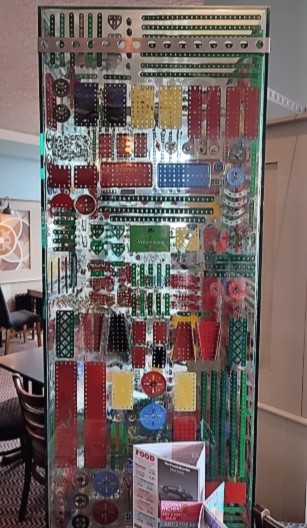 |
Above: Interior displays in The Frank Hornby (1)
As might be expected from this popular chain, the pub offers a variety of drinks, including real ales, wines, spirits and soft drinks. You can also enjoy some delicious food from their menu, which features classic pub favourites, such as fish and chips, burgers, pies and roasts. They also have a range of vegetarian and vegan options, as well as gluten-free and dairy-free dishes. The Frank Hornby pub is a great place to visit and hosts regular events, such as quiz nights, live music and karaoke.
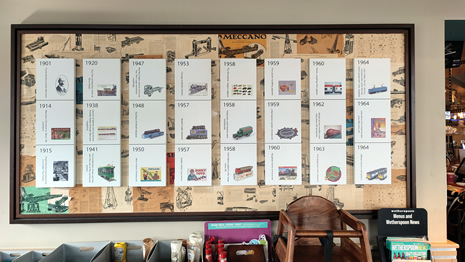 |
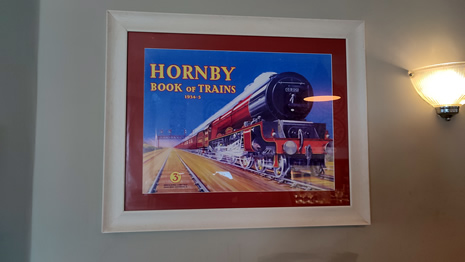 |
|
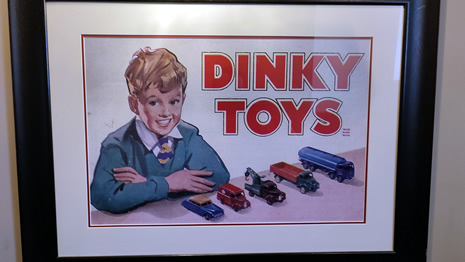 |
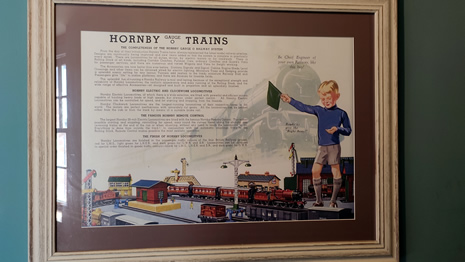 |
|
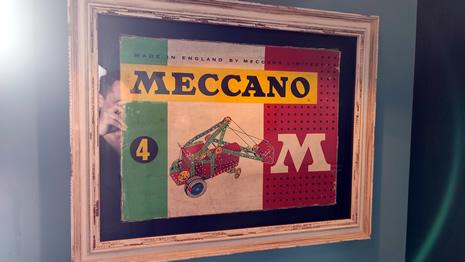 |
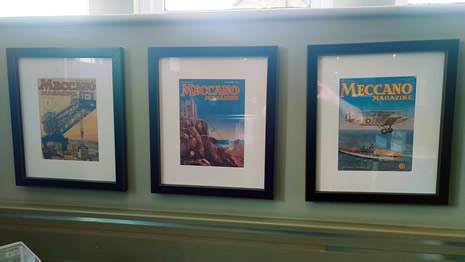 |
|
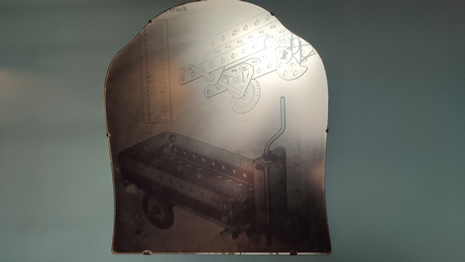 |
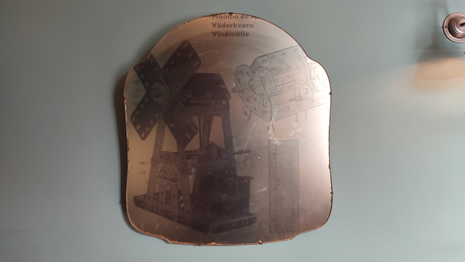 |
Above: Interior displays in The Frank Hornby (2)
Frank Hornby Heritage Centre
The Frank Hornby Heritage Centre in Maghull is a small museum dedicated to the life and legacy of Frank Hornby, the inventor of Meccano, Hornby Model Railways and Dinky Toys. It is located upstairs within Meadows Leisure Centre, Hall Ln, L31 7BB.

In the heritage centre, visitors can learn about the history of Frank Hornby and how he started his toy empire from his home in Maghull. Pictures show his original workshop, where he made his first prototypes of Meccano sets, and his study, where he designed and patented his inventions. Rare photos and documents tell the story of his personal and professional life. On display is also a collection of Hornsby’s products, from the early Meccano sets to the latest Hornby trains. Exhibits are laid out to show how the toys evolved over time, reflecting the changes in technology and society. On show are some of the rarest and most valuable items, such as the first electric train set from 1925, the first Dinky Toy car from 1934 and the first plastic Meccano set from 1962.
At the time of writing, admission is free, but donations are welcome. It is worth checking the opening times before planning a visit. Some photos taken from a visit here can be seen in the thumbnail gallery below (click on an image to enlarge):
Museum of Liverpool
For those not venturing out to Maghull, the Museum of Liverpool (More Here) has a relatively small area displaying some historical Hornby trains, Dinky toys and Meccano. Photos below:
 |
||
 |
 |
|
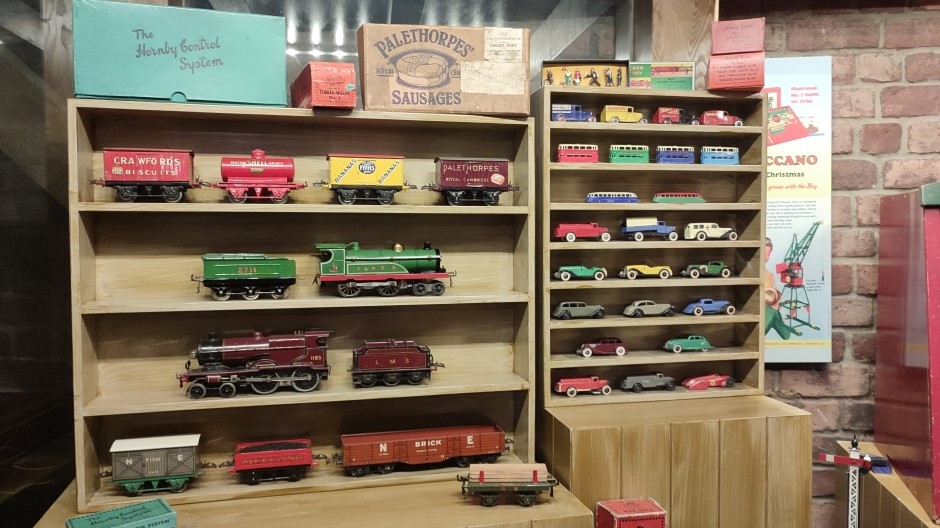 |
||
A Brief History of Meccano
To finish off, and partly for my own personal record, a brief history of Meccano follows:
Meccano is a metal construction system that has been around for more than a century. It consists of various parts such as strips, plates, girders, wheels and gears that can be joined together with nuts and bolts to create models of machines, buildings, vehicles and more. Meccano is not only a toy, but also a learning tool that teaches mechanical engineering principles and stimulates creativity and imagination. It was invented by Frank Hornby in 1898 and patented in 1901.
The name Meccano comes from the phrase "Make and Know", which reflects Hornby's vision of creating a toy that would educate and entertain at the same time. Hornby was inspired by his own experience of working as a clerk in a meat importing company, where he saw how cranes and other machinery operated. He wanted to make a toy that would enable children to learn about engineering and mechanics in a fun way.
Meccano was first sold in England as "Mechanics Made Easy" in 1901. It consisted of 16 different parts that could be assembled into 12 models. The toy was an instant success and Hornby soon expanded his range of parts and models. He also changed the name to Meccano in 1907 and registered it as a trademark.
Meccano became popular all over the world and was manufactured in several countries, including France, Spain, Argentina, Canada and Australia. Meccano also inspired many other construction toys, such as Erector Set, Lego, Tinkertoy and K'Nex. Meccano has been praised for its educational value, as it helps develop spatial awareness, logical thinking, problem-solving and manual skills.
 |
 |
Above: Meccano models of Noah’s Ark, and a “Jovilabe” which shows the rotation of Jupiter and the relative orbits of its 4 Galilean satellites
Meccano has also influenced many famous engineers, inventors and scientists, such as Arthur C. Clarke, Richard Feynman, Alan Turing and Tim Berners-Lee. Some of them even used Meccano to build prototypes of their inventions, such as Turing's Bombe machine that cracked the Enigma code during World War II. The construction toy evolved over the years to keep up with the changing times and tastes of children. The manufacturers introduced new materials, such as plastic and electronics, new themes, such as robotics and space exploration, and new features, such as remote control and programmability. At the time of writing, Meccano is still being produced today by Spin Master, a Canadian toy company that acquired the brand in 2013.
Throughout its history, Meccano notably went through different periods where the parts were produced in different colour schemes. Over the years, Meccano has changed its colours several times, reflecting different trends, markets and regulations. The first Meccano colour scheme was introduced in 1908, when the parts were painted in dark green with red wheels. This was inspired by the colours of steam engines and locomotives of the time. The green colour also helped to prevent rusting of the metal parts. This colour scheme lasted until 1926, when Meccano switched to a nickel-plated finish for most of its parts, except for some special ones that remained green or red.
In 1934, Meccano introduced a new colour scheme that became known as the "New Colours". This consisted of blue and gold parts, with red wheels and gears. The blue and gold colours were chosen to match the colours of the British Empire Exhibition of 1924, where Meccano had a prominent display. The new colours were also more modern and appealing than the nickel-plated finish, which had become dull and tarnished over time. The new colours lasted until 1958, when Meccano changed its colours again to a lighter shade of green and red, with blue pulleys and grey and blue road wheels. The reason for this change was partly to comply with the new regulations that banned lead-based paints, which were harmful to health. The new colours also had a round yellow sticker on the boxes that indicated they were lead-free!
 |
|
Above: A Meccano chess set and a model showing the layout of the Labyrinth of St. Bertin from St. Omer, France
The green and red colour scheme was the most iconic and popular one for Meccano, and it remained until 1964, when Meccano introduced another radical change. This time, the colours were zinc, black and yellow, with silver strips and girders. The yellow and black colours were chosen because they were the colours typically used by most large construction vehicles of the day, such as cranes, bulldozers and excavators. The zinc colour also gave a more metallic look to the parts. However, this colour scheme was not well received by many Meccano fans, who preferred the traditional green and red colours. In 1967, Meccano replaced the black colour with blue, which was more pleasing to the eye. This colour scheme lasted until 1979, when Meccano ceased production in Britain.
Since then, Meccano has been revived by different companies in different countries, such as France, Canada and China. The current Meccano colour scheme is mostly silver and black, with some coloured parts for special sets or models. The silver colour gives a sleek and modern look to the parts, while the black colour provides contrast and definition.Meccano has gone through many changes in its history, but it has always maintained its essence as a metal construction system that inspires creativity and learning. The different colour schemes are part of its history and charm, and they reflect the changing times and tastes of its users. Meccano is more than just a toy; Meccano is a legacy of Frank Hornby's genius and vision. It is a testament to the power of imagination and creativity and, combined with the original Meccano Magazine, a history of engineering and innovation.
[Photos: 24 March 2023 (except for section A Brief History of Meccano), Text: May, 2023]
Back to Top